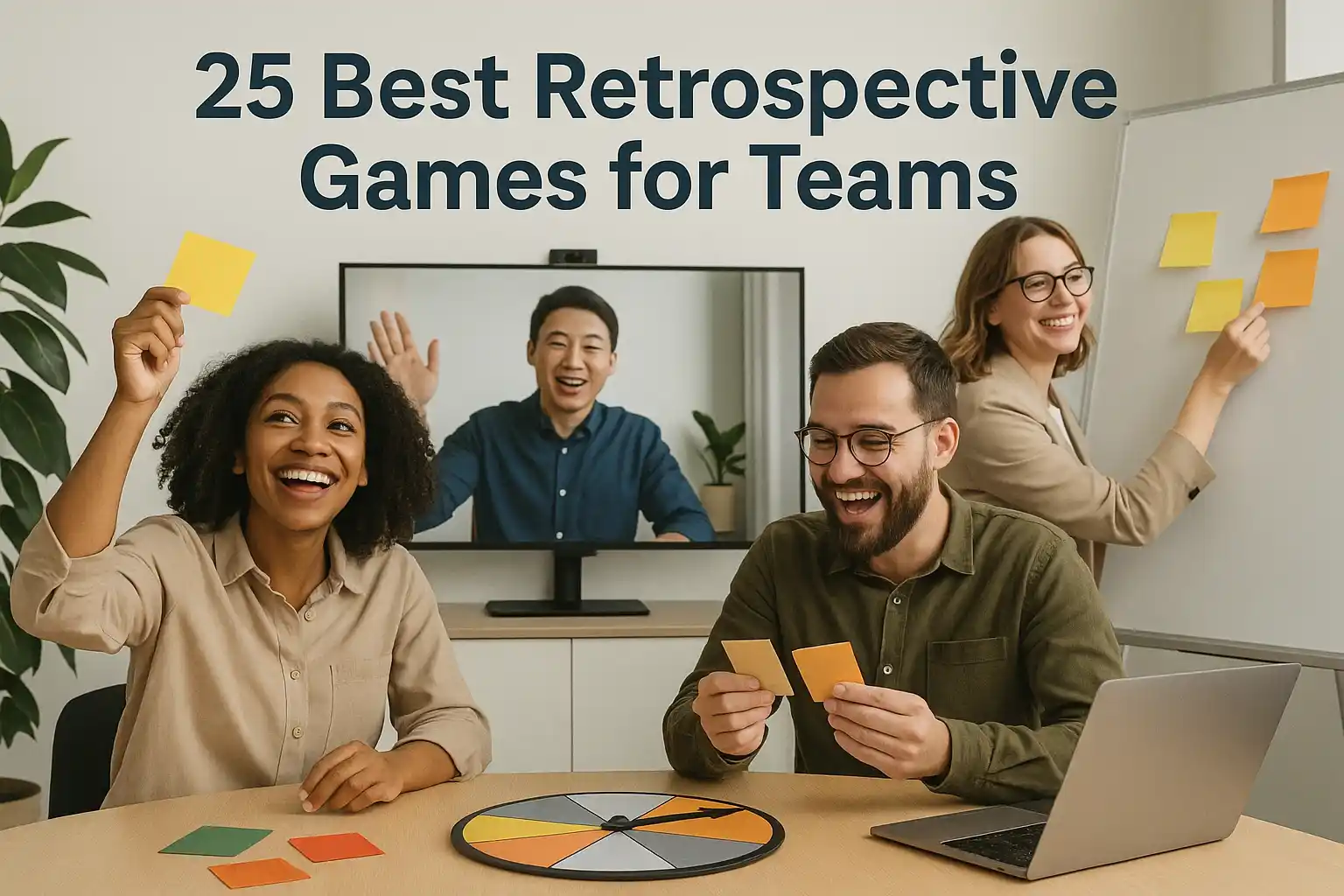

Have you ever wondered why some Agile teams consistently outperform others? According to a recent Parabol study, teams that conduct retrospectives regularly boast 24% more responsiveness and 42% higher quality, while those running effective retros see 20% higher balanced performance. This highlights the immense significance of retrospective games to boost workplace productivity in this day and age.
In this blog, we dive into 25 of the best retrospective games, each thoughtfully designed to spark open dialogue, surface hidden insights, and build psychological safety. Whether you’re a Scrum Master, Agile Coach, CTO, or startup leader, these engaging activities will help every team reflection feel purposeful, energizing, and results-driven.
So, are you ready to transform your next retro into a powerful catalyst for continuous improvement? Let’s delve right in.
Retrospective games are interactive, engaging activities used by Agile teams to reflect on their recent sprint, project, or workflow in a fun, structured way. Unlike traditional retros, these games spark creativity, encourage honest feedback, and promote psychological safety, thereby making it easier for team members to share openly.
Rooted in Agile principles, these fun retrospective games aim to uncover what went well, what could improve, and how the team can evolve. Whether it’s a physical board, a digital tool, or a storytelling format, these games turn routine reflections into dynamic sessions that drive continuous improvement and strengthen team cohesion.
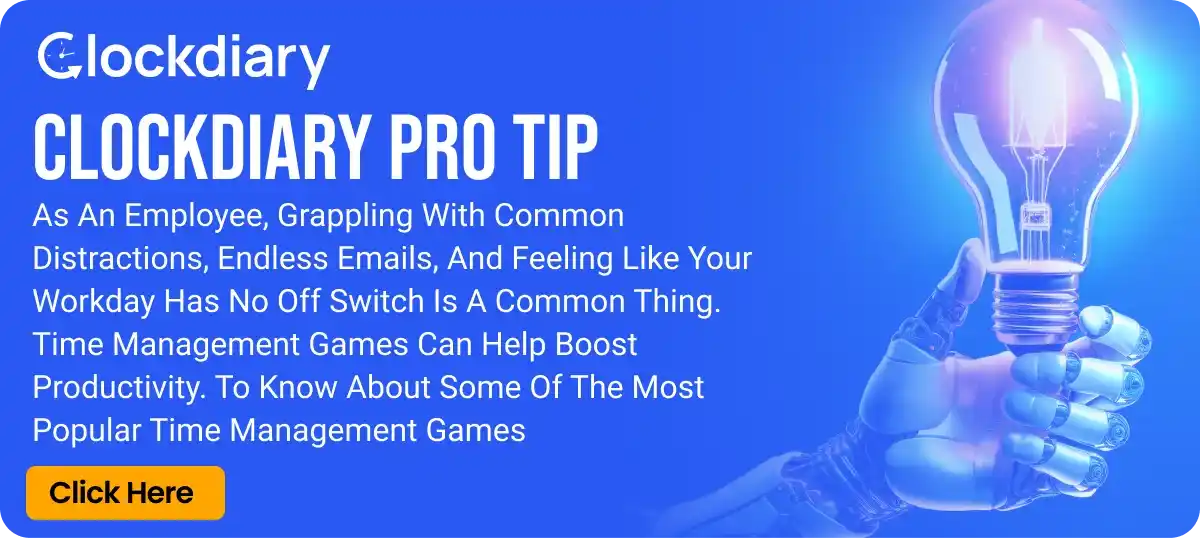
Choosing the right retrospective game isn’t about picking the most fun option. It’s about aligning with your team’s mindset, goals, and working style. Here’s how to make a thoughtful choice that truly enhances reflection and drives improvement.
All these things cumulatively help in building a high performing team.
After the retro, ask the team what worked, what didn’t, and what they’d like to try next time. This feedback loop helps you continually refine and personalize future retrospectives.
Working remotely can create invisible walls between team members, making it harder to build trust and engagement during retrospectives. That’s where icebreaker games for retrospective come in. They warm up the room, boost energy, and help distributed teams feel more connected, even across time zones.
These simple yet powerful activities break down barriers, encourage participation, and set a collaborative tone for deeper reflection. Whether your team is new, distributed, or just needs a spark, icebreaker retrospective games are the perfect starting point.
Below are some of the best virtual-friendly options to kick off your remote retros with impact and ease.
The ESVP Retrospective Game (Explorer, Shopper, Vacationer, Prisoner) is a powerful pre-retrospective activity that helps facilitators gauge team engagement and emotional readiness.
Goal: The ESVP (Explorer, Shopper, Vacationer, Prisoner) game helps facilitators gauge team members’ emotional engagement in the retrospective. It’s a quick pulse-check that fosters psychological safety by surfacing how people really feel about being in the room.
Team Size: ESVP is one of the best retrospective games online for small to medium-sized teams (5–12 members), but easily scalable for larger groups using anonymous polls or breakout rooms.
Duration: 5 – 10 minutes
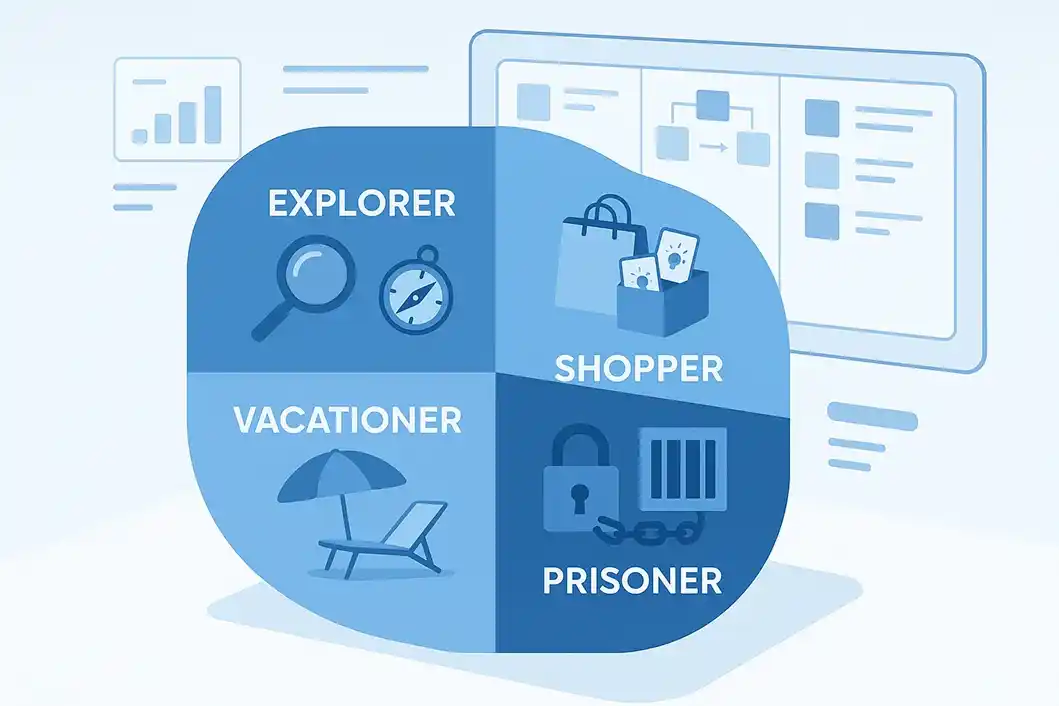
Materials
How to Play ESVP Retrospective Game?
Facilitator Tips:
The ESVP game builds trust and awareness, helping you meet your team where they are, mentally and emotionally, so your retrospective can be more empathetic, focused, and effective.
“Two Truths and a Lie” is a fun, lighthearted icebreaker adapted for retrospectives to spark conversation, loosen up remote teams, and promote psychological safety. This free retrospective game for remote teams blends team bonding with reflective insights, making it ideal for starting virtual retros.
Goal: This retro game console builds rapport and psychological safety by encouraging team members to share personal or work-related experiences in a light-hearted way. It’s ideal for warming up the group and promoting openness before diving into deeper retrospective topics.
Team Size: Works well for teams of 4–12 people. In larger groups, consider using breakout rooms to maintain engagement.
Duration: 10–15 minutes, depending on team size.
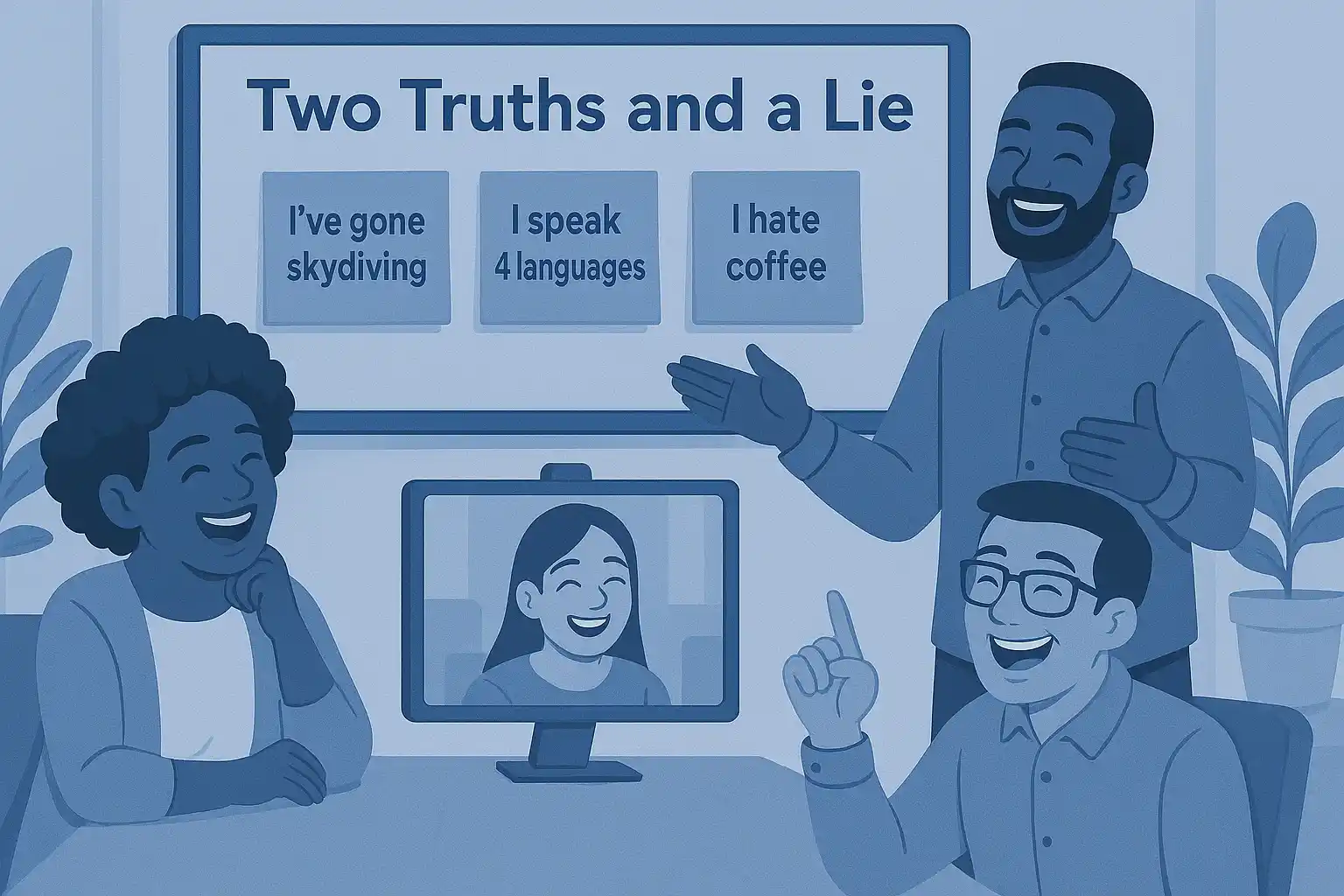
Materials:
How to Play Two Truths And A Lie Retrospective
Facilitator Tips:
Two truths and a lie, one of the best free online retrospective games is a creative way to combine fun with reflection, thereby helping teams surface lessons learned and shared experiences while building trust and engagement.
The Snapshot Gallery retrospective is a visually engaging and reflective retrospective game that invites team members to summarize their sprint experience as if they were capturing a single moment in time, a “snapshot.”
This game fosters creativity, emotional expression, and storytelling, making it ideal for both in-person and remote teams.
Goal: To reflect on the sprint through metaphorical thinking and visual storytelling, promoting empathy and deeper understanding of individual perspectives.
Team Size: Ideal for 4–10 participants. Easily scalable with breakout rooms for larger groups.
Duration: 20–30 minutes.
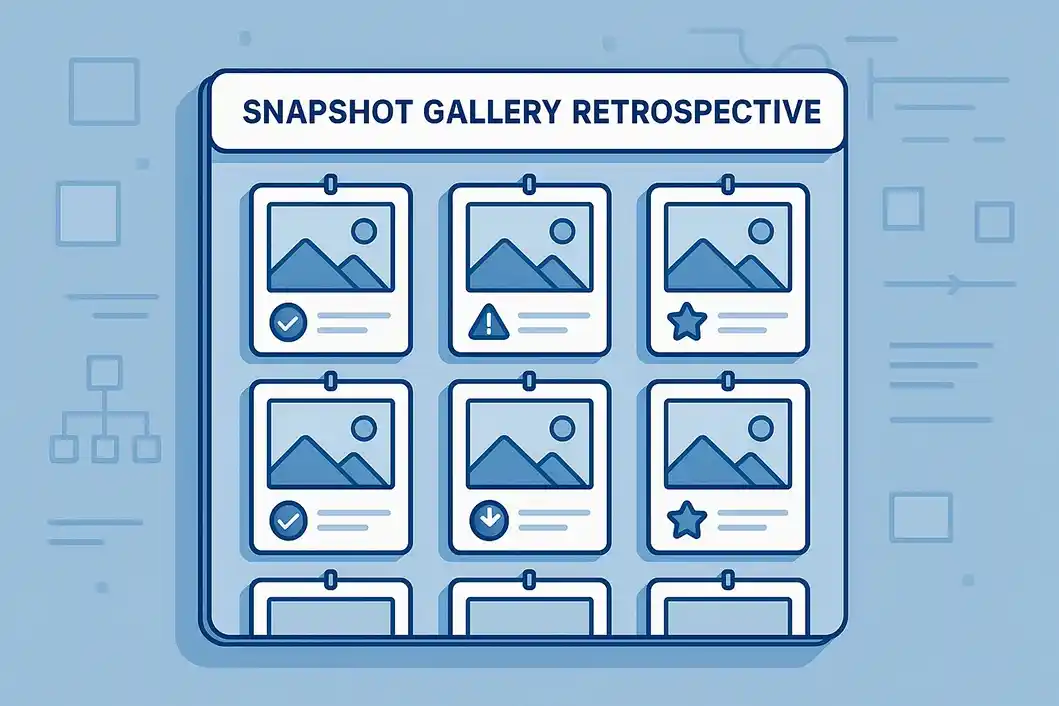
Materials:
How to Play Snapshot Gallery Retrospective?
Facilitator Tips
Snapshot Gallery is a powerful way to surface hidden insights and emotional truths while building team empathy. It’s one of the best fun retrospective games for remote teams that need a fresh, creative spark.
Sprint Animals is a fun, metaphor-driven retrospective game where team members reflect on their sprint by choosing an animal that represents their experience.
This sprint game is a lighthearted yet meaningful way to surface emotions, challenges, and highlights without diving directly into business metrics or tasks.
Goal: To encourage open, emotional reflection using metaphors that reveal team sentiment, mindset, and morale in a safe, creative way.
Team Size: Best suited for 4–12 participants.
Duration: 15–25 minutes.
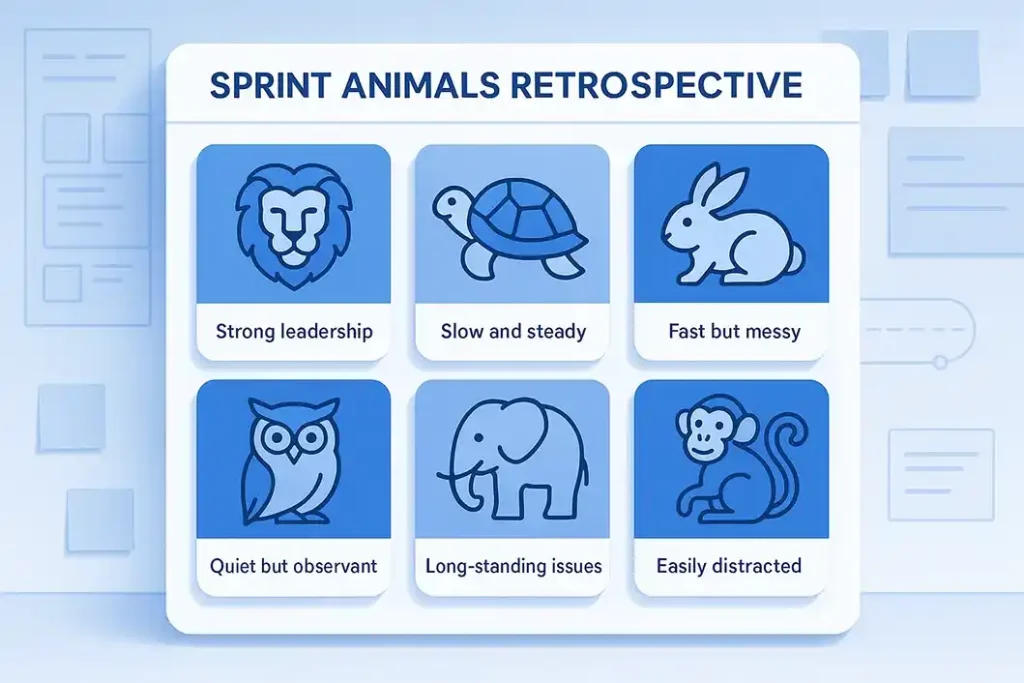
Materials:
How to Play Sprint Animals Retrospective Game?
Faciliator Tips
Sprint Animals offers a playful entry point into serious conversations. It’s one of the most sought-after fun retrospective ideas for remote teams when team morale needs a lift or when retros feel too routine or data-heavy.
The Travel Truths and Lies Retrospective puts a creative spin on the classic icebreaker by inviting team members to share travel-themed stories—some true, some false. This is one of the best retrospective games online that energizes remote teams, builds rapport, and gently eases participants into reflective thinking without diving straight into sprint analysis.
Goal: To encourage connection and engagement through storytelling while warming up the team for deeper retrospective conversations.
Team Size: This retrospective game remote is Ideal for 4–10 participants. Works in larger teams using breakout rooms.
Duration: 15–20 minutes.
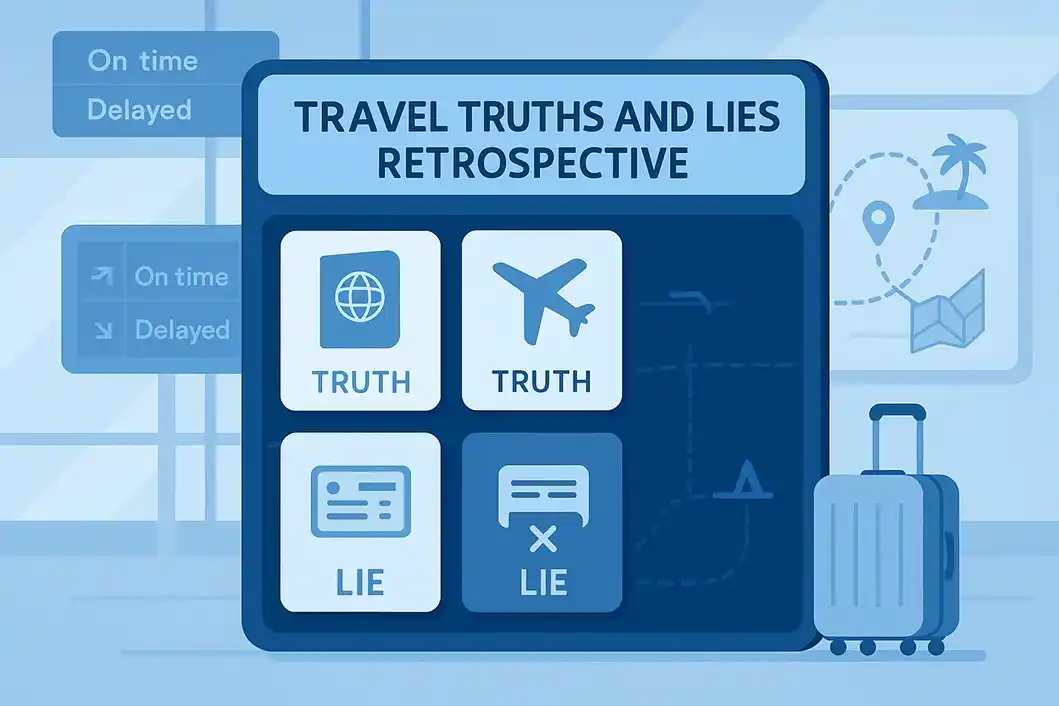
Materials:
How to Play Travel Truths and Lies Retrospective
Facilitator Tips
Travel Truths and Lies builds camaraderie and psychological safety, making it one of the best retrospective games for remote teams or newly formed ones. It’s an ideal opener when you want to make retros more human and enjoyable.
Scrum retrospectives are a vital part of continuous improvement, but without variety, they can easily become repetitive or surface-level. That’s where scrum sprint retrospective games come in. These games to play at a club meeting are structured, engaging activities that help Scrum teams reflect deeply, communicate honestly, and take meaningful action.
Sprinter games transform routine meetings into collaborative sessions that drive real change. Whether your team is co-located or remote, experienced or just starting Agile, the right game can re-energize your retros and boost team morale.
Below, we’ve curated the best retrospective games specifically tailored for Scrum teams to keep your Agile ceremonies fresh, focused, and impactful.
The Mad, Sad, Glad retrospective is a classic emotional-check-in game that helps Scrum teams reflect on their experiences from a human-centered perspective. By encouraging team members to express their emotions about the sprint,this sprint gaming creates space for empathy, honesty, and improved psychological safety.
Goal: To surface emotional insights, both positive and negative, that influence team dynamics, engagement, and performance.
Team Size: Best suited for 4–10 participants; can be adapted for larger groups using breakout sessions.
Duration: 20–30 minutes.

Materials:
How to Play Mad, Sad, Glad Retrospective?
Facilitator Tips
Mad, Sad, Glad is a simple yet powerful sprinters game to bring emotion into retrospectives, deepen team understanding, and drive more meaningful change.
The Start, Stop, Continue retrospective is one of the most practical and action-oriented sprint games used by Scrum teams. It simplifies sprint reflection into three focused areas, making it easy for teams to identify what’s working, what isn’t, and where to experiment next.
Goal: To generate actionable insights by categorizing team activities and behaviors into three clear segments—what to begin doing, stop doing, and continue doing.
Team Size: Ideal for 4–12 participants.
Duration: 20–30 minutes.
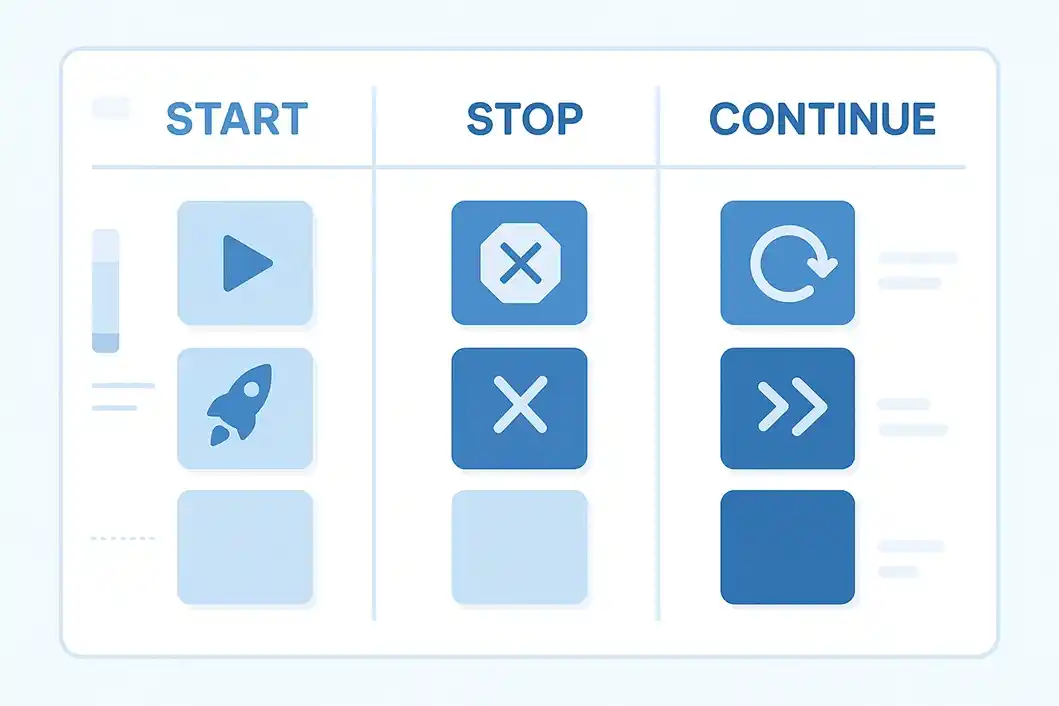
Materials:
How to Play Start, Stop, Continue Retrospective?
Facilitator Tips
Start, Stop, Continue is perfect for Scrum teams that want clarity and momentum. It helps translate feedback into action and fosters a culture of continuous improvement with minimal complexity.
The Constellation Retrospective is an interactive and visual sprint activity that helps Scrum teams explore differing perspectives on team dynamics, collaboration, and shared experiences. It’s especially impactful for surfacing unspoken opinions and building awareness of team alignment, or misalignment, on key issues.
Goal: To visualize where team members stand on specific topics and uncover varying perceptions in a safe, non-confrontational way.
Team Size: Ideal for 5–15 participants. Works well for co-located or remote teams with the right tools.
Duration: 20–30 minutes.
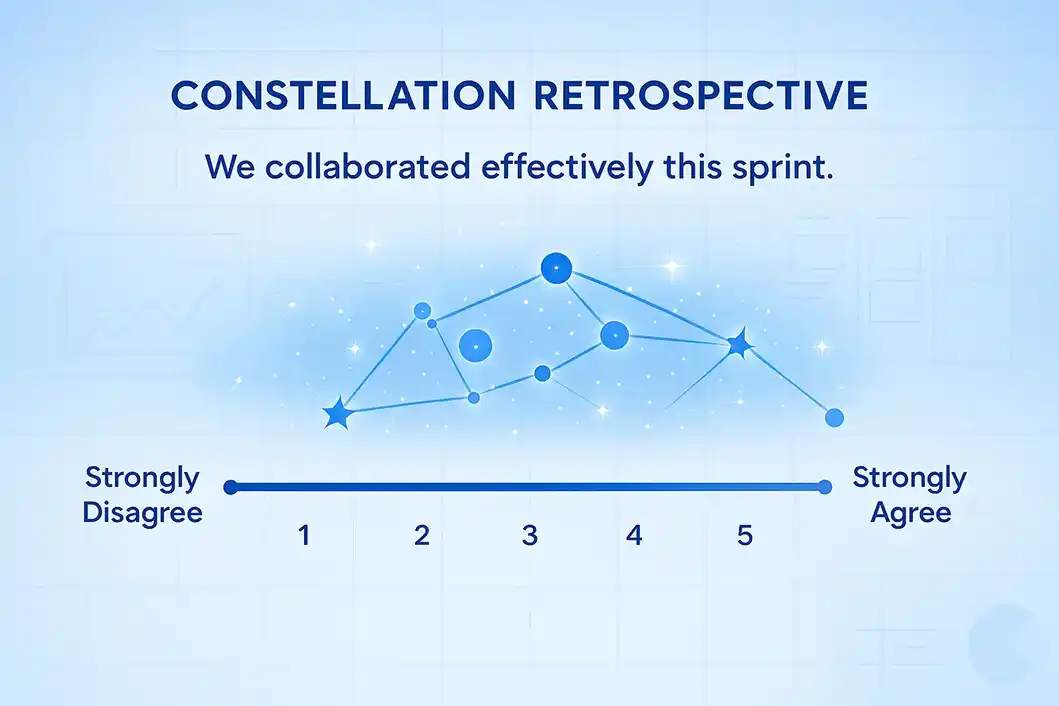
Materials:
How to Play Constellation Retrospective Game?
Facilitator Tips
Constellation is one of the best sprinting games for revealing team sentiment and alignment. It invites honest reflection and deepens understanding, especially when addressing team health, values, or decision-making.
The Retrospective Riddle Game adds a fun and mysterious twist to your sprint retrospective by combining problem-solving with team reflection. This game challenges team members to decode riddles that represent events, issues, or wins from the sprint, sparking curiosity, discussion, and engagement.
Goal: To encourage creative thinking and reflection while making retrospectives more interactive and enjoyable.
Team Size: Works best with 4–10 participants; suitable for both remote and in-person teams.
Duration: 20–30 minutes.
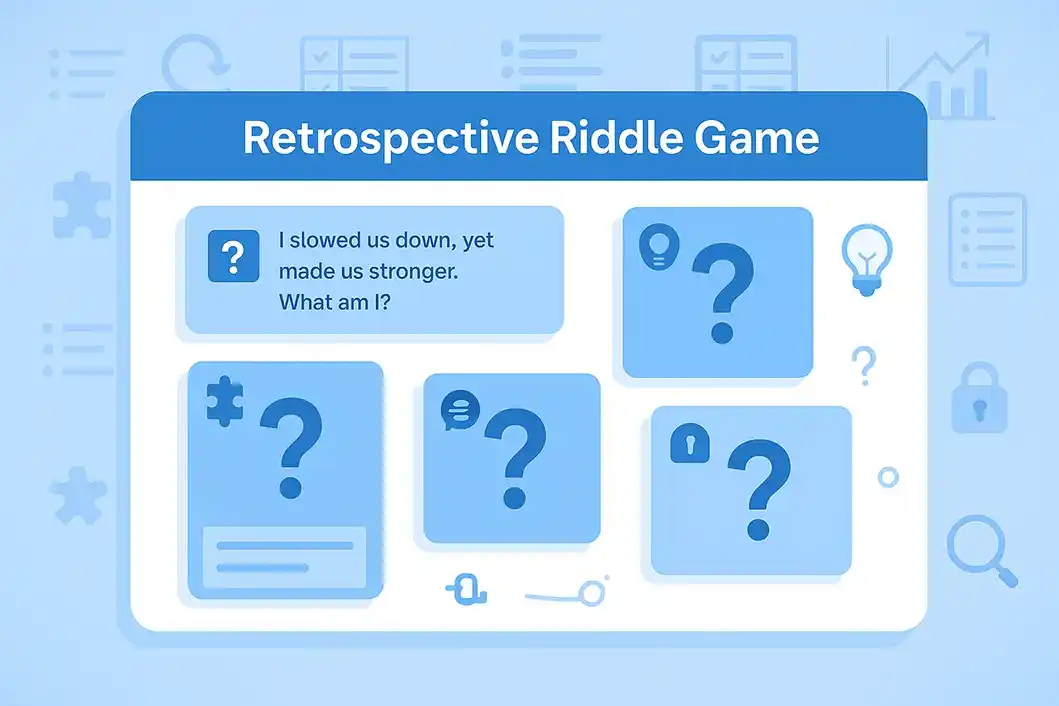
Materials:
How to Play Retrospective Riddle Game?
Facilitator Tips
The Retrospective Riddle Game transforms typical fun retros into an engaging and reflective experience. It helps teams surface issues creatively, build shared understanding, and have fun while learning.
The Letter to Former Self retrospective is a thoughtful, introspective activity that encourages team members to reflect on their past sprint experiences with hindsight.
By writing a letter to their “past self” at the start of the sprint the game, team members identify key learnings, surprises, and emotional takeaways.
Goal: To promote self-reflection, emotional awareness, and growth by capturing what team members wish they had known at the beginning of the sprint.
Team Size: Works well with 4–12 participants. Adaptable for both co-located and remote teams.
Duration: 25–30 minutes.
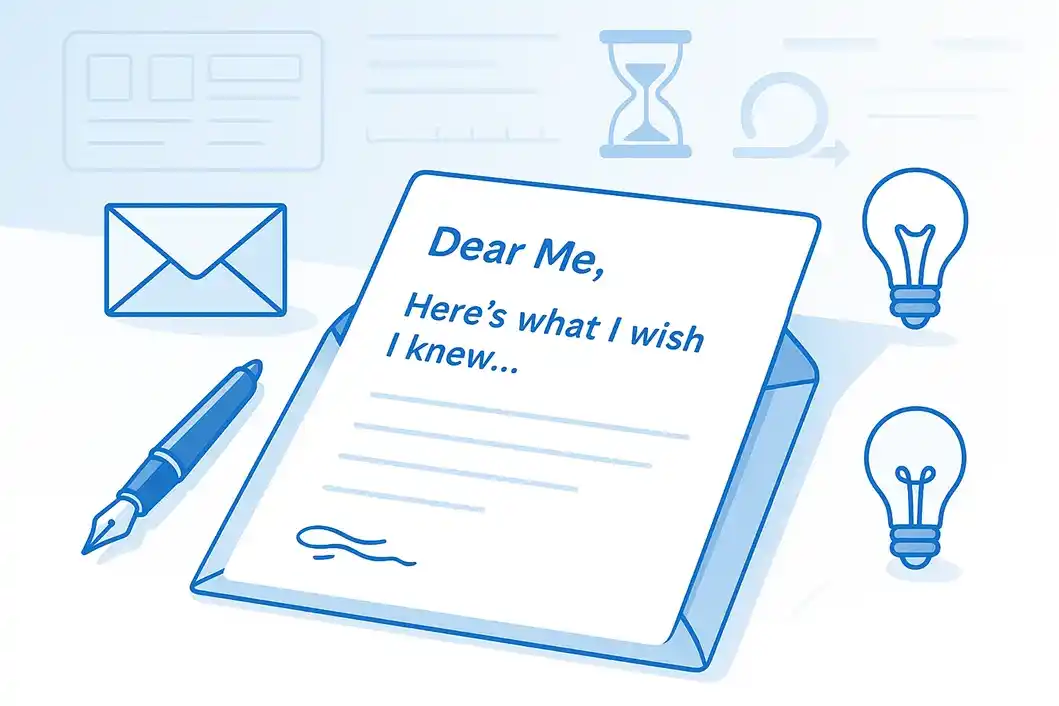
Materials:
How to Play Letter to Former Self Retrispective
Facilitator Tips
Letter to Former Self is a powerful way to turn reflection into personal growth. It strengthens emotional intelligence, builds trust, and leaves team members more mindful heading into the next sprint.
Draw the Sprint is a visual and creative video game retrospectives that invites team members to illustrate their sprint experience instead of talking about it directly. Perfect for both remote and co-located teams, this activity encourages self-expression, emotional insight, and lighthearted engagement.
Goal: To reflect on the sprint through visuals and metaphors, promoting deeper conversations through creative interpretation and storytelling.
Team Size: Ideal for 4–10 participants. Works well with distributed teams using drawing tools.
Duration: 20–30 minutes.
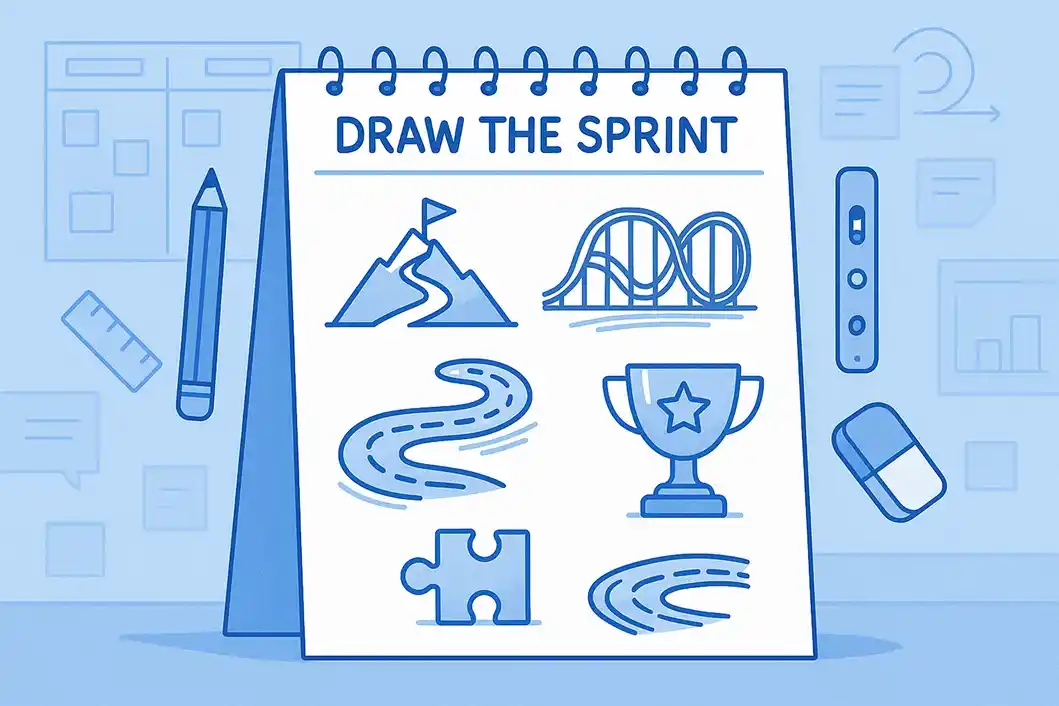
Materials:
How to Play Draw The Sprint Retrospective?
Facilitator Tips
Draw the Sprint makes retrospectives more engaging, especially for teams fatigued by standard formats. It unlocks creativity, brings emotion into focus, and often reveals powerful insights that words alone can’t express.
The Failing Forward Retrospective is a growth-oriented activity that helps teams reframe failure as an opportunity for learning and innovation. Instead of avoiding mistakes, this sprint run game encourages open conversation about what went wrong, why it happened, and how to improve moving forward.
Goal: To normalize failure, extract lessons from setbacks, and create a psychologically safe environment that supports continuous improvement.
Team Size: Best for 4–12 participants; works in both remote and in-person setups.
Duration: 25–35 minutes.
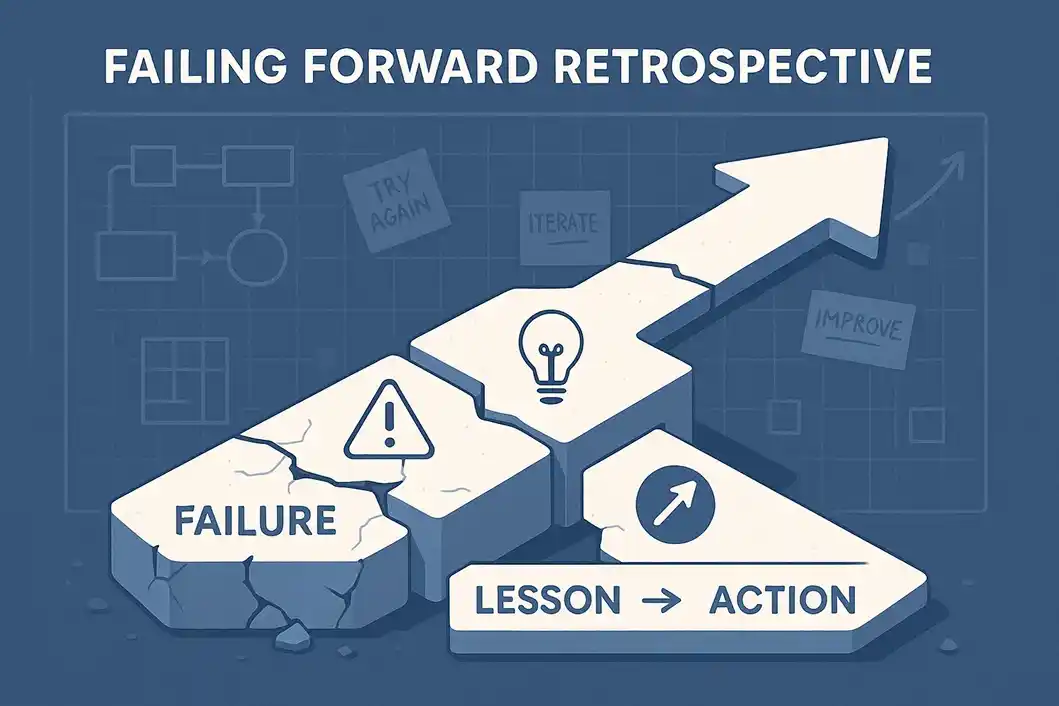
Materials:
How to Play Failing Forward Retrospective?
Facilitator Tips
Failing Forward promotes a resilient, growth-mindset culture. By owning mistakes together, Scrum teams become more adaptive, collaborative, and empowered to take smarter risks in future sprinter games.
Are you tired of retrospectives that spark discussion but lead nowhere? Action-oriented retrospective games are designed to bridge the gap between reflection and execution. These activities focus on turning team insights into tangible next steps, thereby making retros not just a time to talk, but a launchpad for real improvement.
Especially valuable for Scrum Masters, Agile Coaches, and tech leaders, these games help prioritize issues, assign ownership, and foster accountability. Whether your team struggles with follow-through or just wants to boost effectiveness, action-focused retros ensure that every session ends with clear, motivating outcomes that actually move the needle.
The SMART Action Plan free online retrospective game helps teams transform vague ideas into concrete, achievable action items. By applying the SMART criteria—Specific, Measurable, Achievable, Relevant, and Time-bound, this retrospective ensures that team takeaways are actionable, realistic, and trackable.
Goal: To align the team on clearly defined improvement steps that are structured for follow-through and impact.
Team Size: Ideal for 4–12 participants.
Duration: 25–35 minutes.
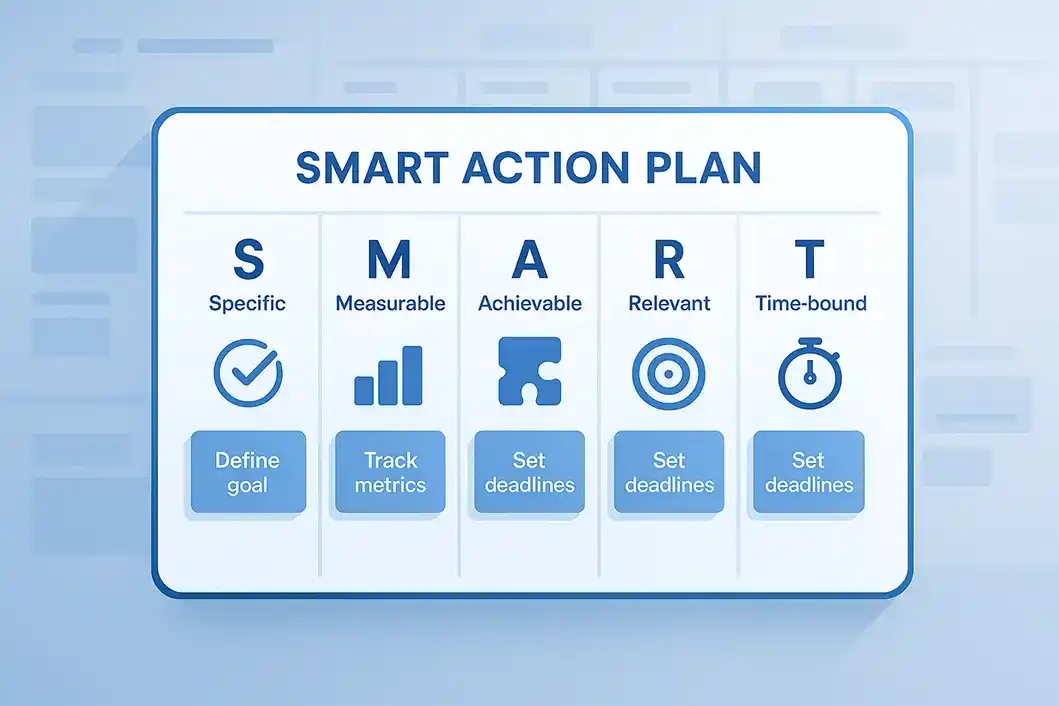
Materials:
How to Play SMART Action Plan Retrospective?
Facilitator Tips
The SMART Action Plan Retro games console keeps retros focused, productive, and measurable. It helps teams commit to real change while fostering accountability and continuous improvement.
The Return on Time Invested (ROTI) retrospective is a quick yet powerful activity that helps teams evaluate the effectiveness of the retrospective itself. By asking team members to reflect on the value they received compared to the time spent, this video game retrospective ensures continuous improvement, not just in delivery, but in the retrospective process itself.
Goal: To measure the perceived value of the retrospective and gather feedback to improve future sessions.
Team Size: Works well with 3–15 participants.
Duration: 10–15 minutes.
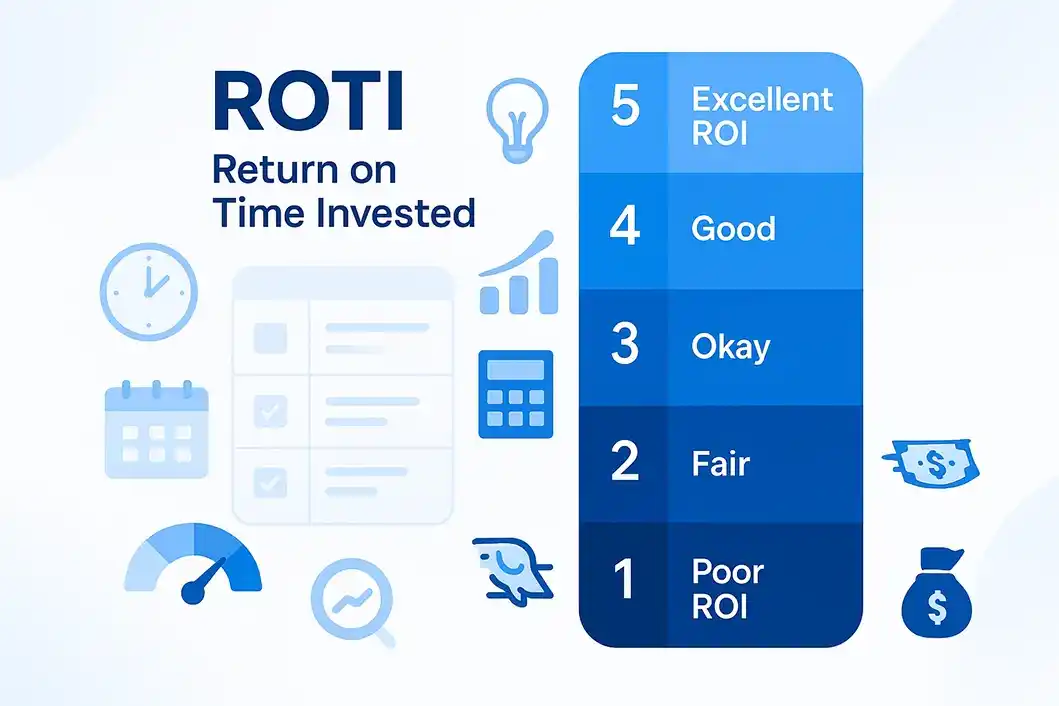
Materials:
How to Play Return on Time Invested Retrospective?
Facilitator Tips
The ROTI Retrospective is a quick feedback loop that shows your team their time matters. This cool retrospective game builds trust and ensures retrospectives continue to evolve and add real value.
The Kudo Cards Retrospective is a gratitude-centered activity that focuses on team recognition and appreciation. Rooted in the belief that positive reinforcement strengthens collaboration, this fun retrospective game encourages team members to celebrate each other’s contributions during the sprint.
Goal: To boost morale, reinforce positive behaviors, and nurture a culture of appreciation within Agile teams.
Team Size: Ideal for teams of 3–15 people.
Duration: 15–25 minutes.
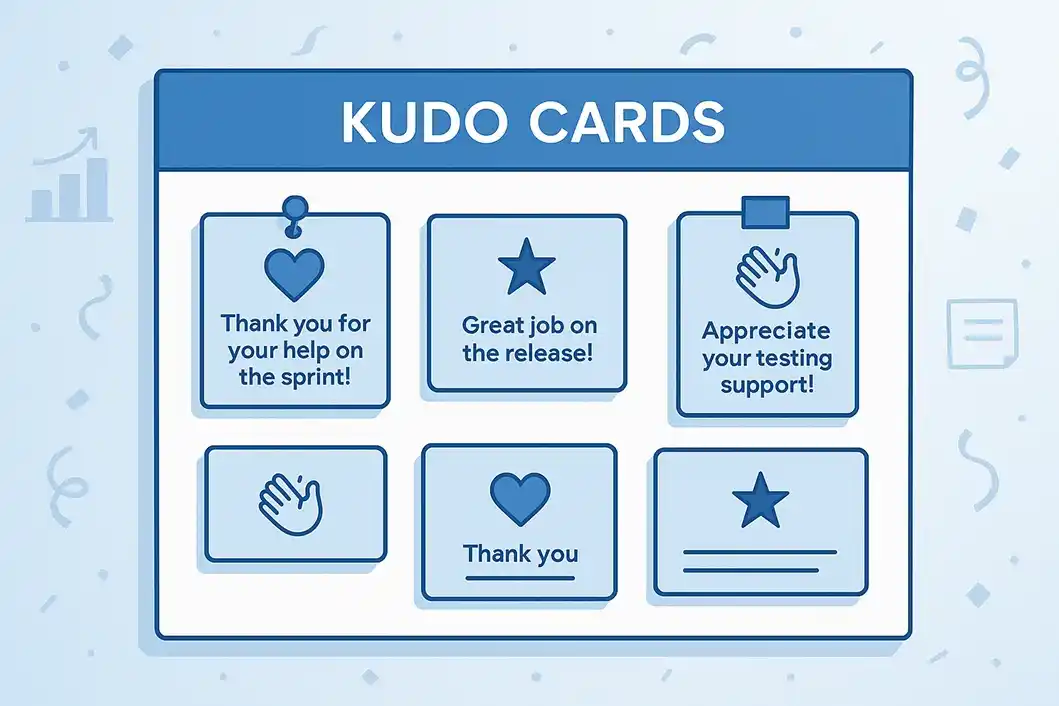
Materials:
How to Play Kudo Cards Retrospective?
Facilitator Tips
Kudo Cards strengthen team bonds and promote a culture of continuous recognition. It’s a simple, uplifting way to end a retrospective on a high note and inspire motivation for the sprint ahead.
The Temperature Check Retrospective is a fast and effective way to gauge the emotional climate of your team before diving into deeper discussions. This check-in retrospective online activity helps identify how team members feel about the sprint runner game, providing early insights into morale, stress levels, and psychological safety.
Goal: To quickly assess team sentiment and uncover hidden tensions or energy levels that may impact collaboration and performance.
Team Size: Suitable for 3–15 participants; easily adapted for remote or in-person teams.
Duration: 10–15 minutes.
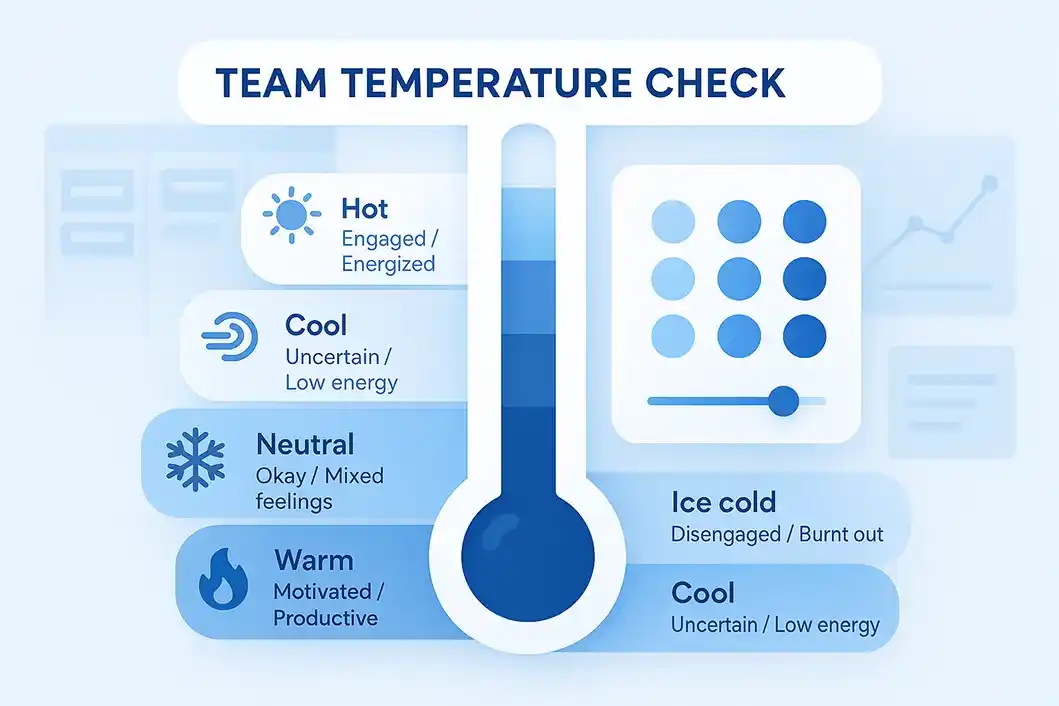
Materials:
How to Play Temperature Check Retrospective?
Facilitator Tips
The Temperature Check is a simple yet powerful pulse-check tool. It sets the emotional tone for retrospectives, helping leaders detect issues early and guide the team toward healthier, more productive collaboration.
The One Word Summary Retrospective is a quick and insightful activity that encourages team members to distill their sprinter runner game experience into a single word. It’s a simple yet powerful exercise that reveals emotions, perceptions, and themes without requiring lengthy explanations, making it perfect as an opener or closer to any retrospective session.
Goal: To capture the overall sentiment of the team in a concise, emotionally resonant format that sparks discussion and reflection.
Team Size: Great for teams of 3–15 members.
Duration: 10–15 minutes.
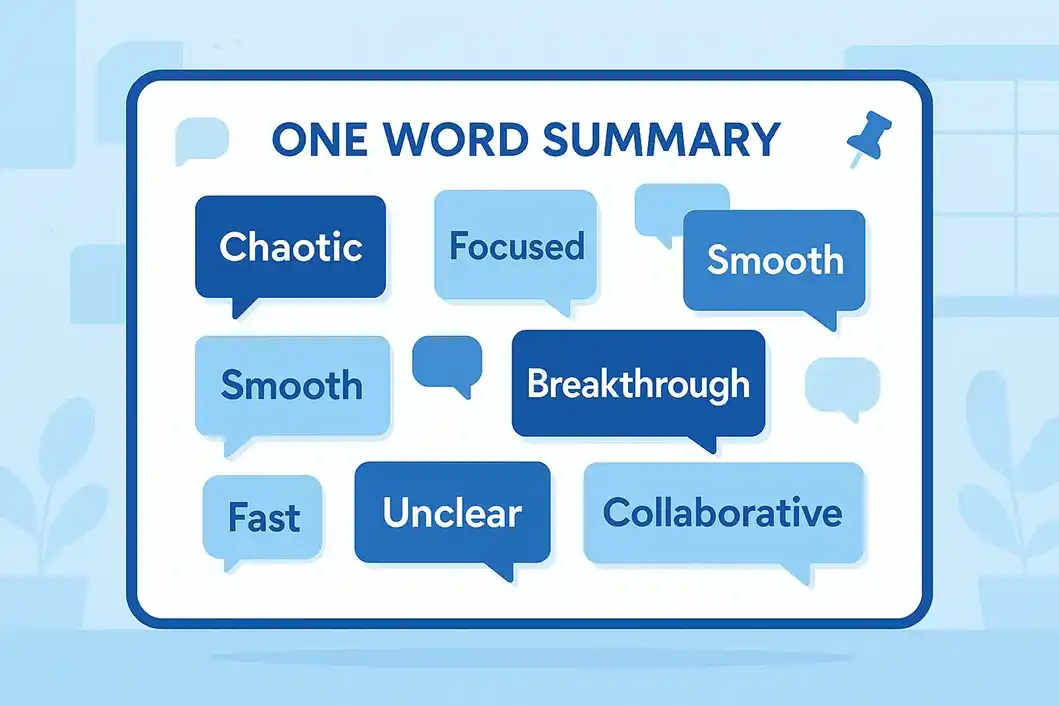
Materials:
How to Play One Word Summary Retrospective?
Facilitator Tips
The One Word Summary offers a fast and meaningful snapshot of team sentiment. It’s one of the best retrospective games online for engaging teams with minimal time and effort, while still uncovering emotional undercurrents and shared experiences.
Running retrospectives with hybrid teams, where some members are remote and others are in the office, can be tricky. Engagement gaps, uneven participation, and tech limitations often reduce the impact of these sessions. That’s why fun retrospectives games specifically designed for hybrid setups are essential.
These retro games create a shared, inclusive experience that bridges the physical divide, energizes participants, and builds team cohesion. Whether you’re an Agile coach, Scrum Master, or team lead, the following games are easy to facilitate and ensure that everyone, remote or onsite, feels equally involved, heard, and inspired to contribute to continuous improvement.
The LEGO Sprint Build Retrospective is a highly engaging, hands-on activity that taps into the power of metaphor and creativity. By using LEGO bricks to represent sprint experiences, team members can express thoughts and feelings in a visual, non-verbal way, making this retro game talk perfect for mixed hybrid teams who benefit from tactile and visual cues.
Goal: To promote reflection through creative expression, storytelling, and metaphor, helping teams surface insights that might not emerge in traditional discussions.
Team Size: Works best with 4–10 participants; hybrid-friendly with some setup.
Duration: 30–45 minutes.
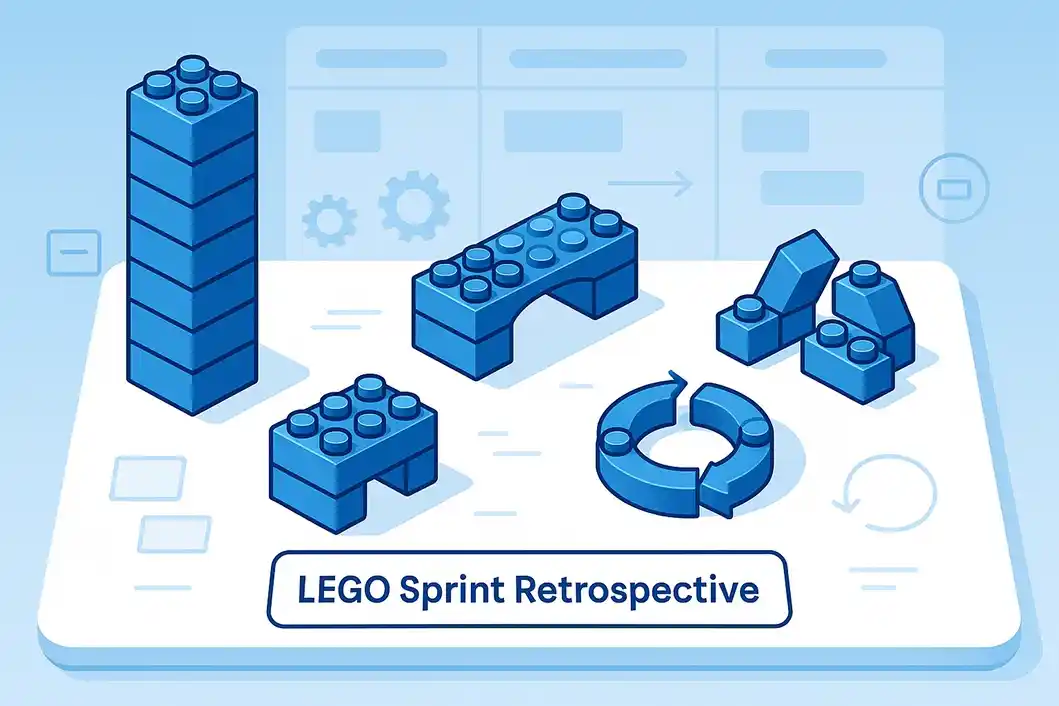
Materials:
How to Play LEGO Sprint Build Retrospective?
Facilitator Tips
The LEGO Sprint Build Retrospective adds fun, depth, and novelty to hybrid retrospectives. It breaks communication barriers, invites deeper emotional insight, and creates memorable moments of team connection.
The Agile Battleship Retrospective is a strategic and interactive game that transforms sprint reflection into a collaborative, problem-solving experience. Inspired by the classic board game, this retrospective vintage helps teams identify hidden blockers, misalignments, and areas of inefficiency, turning retrospectives into a fun yet highly insightful exercise.
Goal: To uncover hidden issues (“ships”) that impacted the sprint and explore ways to improve teamwork, communication, and delivery.
Team Size: Best for 4–12 participants; works well in hybrid or remote setups.
Duration: 30–40 minutes.
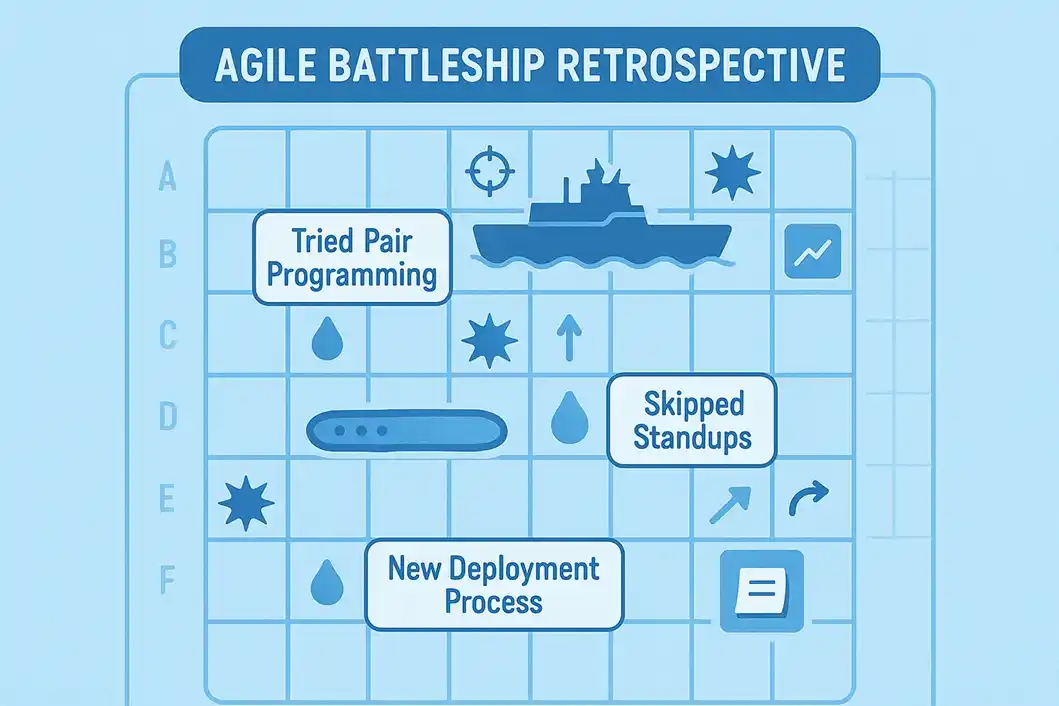
Materials:
How to Play Agile Battleship Retrospective Game?
Facilitator Tips:
Agile Battleship turns retrospectives into a game of discovery and insight. It adds energy, encourages honest conversations, and helps teams navigate complexity with a spirit of collaboration and continuous improvement.
Retros Against Humanity is a fun, edgy twist on traditional retrospectives, modeled after the popular game Cards Against Humanity. Designed to inject humor and creativity into team reflection, this retro game emulator uses fill-in-the-blank prompts and unexpected answers to spark laughter, surface insights, and break down communication barriers.
Goal: To encourage open conversation, lighten the mood, and foster psychological safety while still surfacing genuine sprint reflections and team dynamics.
Team Size: Ideal for 4–10 participants; adaptable for hybrid and remote teams.
Duration: 30–40 minutes.
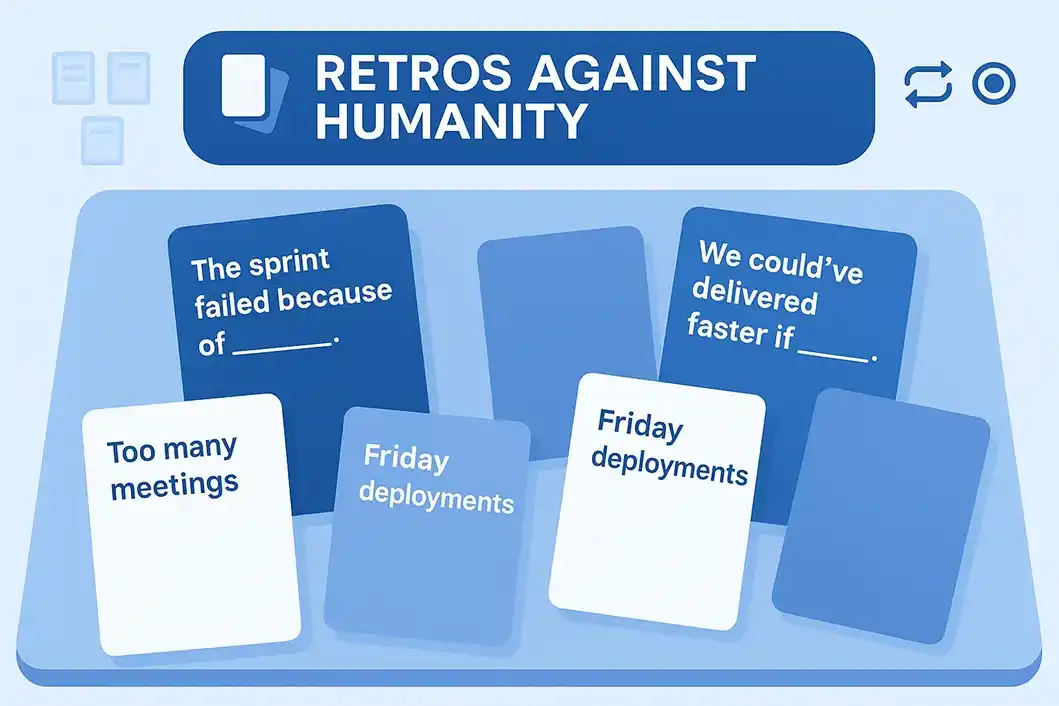
Materials:
How to Play Retros Against Humanity?
Facilitator Tips
Retros Against Humanity adds levity and energy to retrospectives while uncovering real team pain points. It’s one of the best retrospective games for loosening up tense teams, sparking creativity, and building a stronger team culture through laughter and honest reflection.
The Team Pet Retrospective is a playful and metaphor-driven activity that invites teams to reflect on their sprint by imagining the team as a pet. What kind of pet were you this sprint—a loyal dog, a chaotic parrot, a sleepy cat, or maybe a neglected goldfish?
This lighthearted fun retrospective game for remote teams sparks creativity and opens up honest conversations in a non-threatening way.
Goal: To encourage metaphorical thinking and team-level reflection in a fun, emotionally safe format that promotes discussion and connection.
Team Size: Best suited for 4–12 participants; ideal for remote, hybrid, or co-located teams.
Duration: 20–30 minutes.
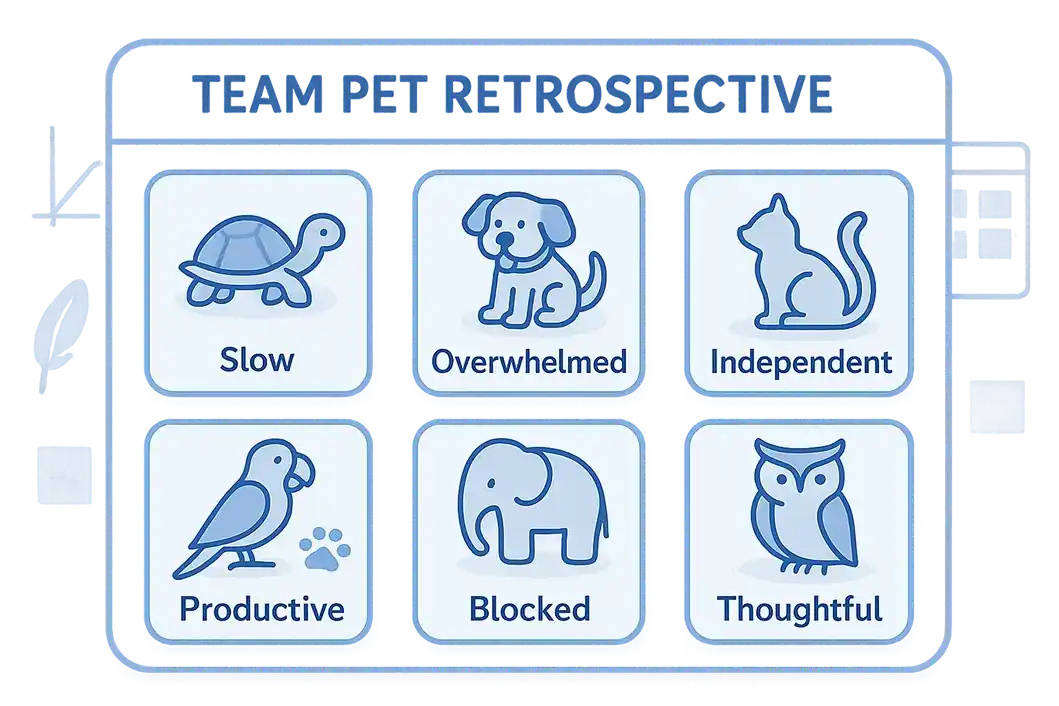
Materials:
How to Play Team Pet Retrospective Game?
Facilitator Tips:
The Team Pet Retrospective brings humor and honesty together, making retrospectives more enjoyable and revealing. It strengthens team bonds and helps surface dynamics that might otherwise go unnoticed.
The Reset Button Retrospective is a powerful reflection game that invites teams to imagine hitting a “reset” on the past sprint. It helps identify what they would redo, undo, or approach differently if given a second chance.
This forward-thinking retrospective game remote or in-person promotes learning from mistakes, challenging assumptions, and embracing continuous improvement.
Goal: To explore missed opportunities, reflect on decisions, and align the team around better strategies and habits for future sprints.
Team Size: Works best with 4–12 participants; suitable for remote, hybrid, or in-person teams.
Duration: 25–30 minutes.
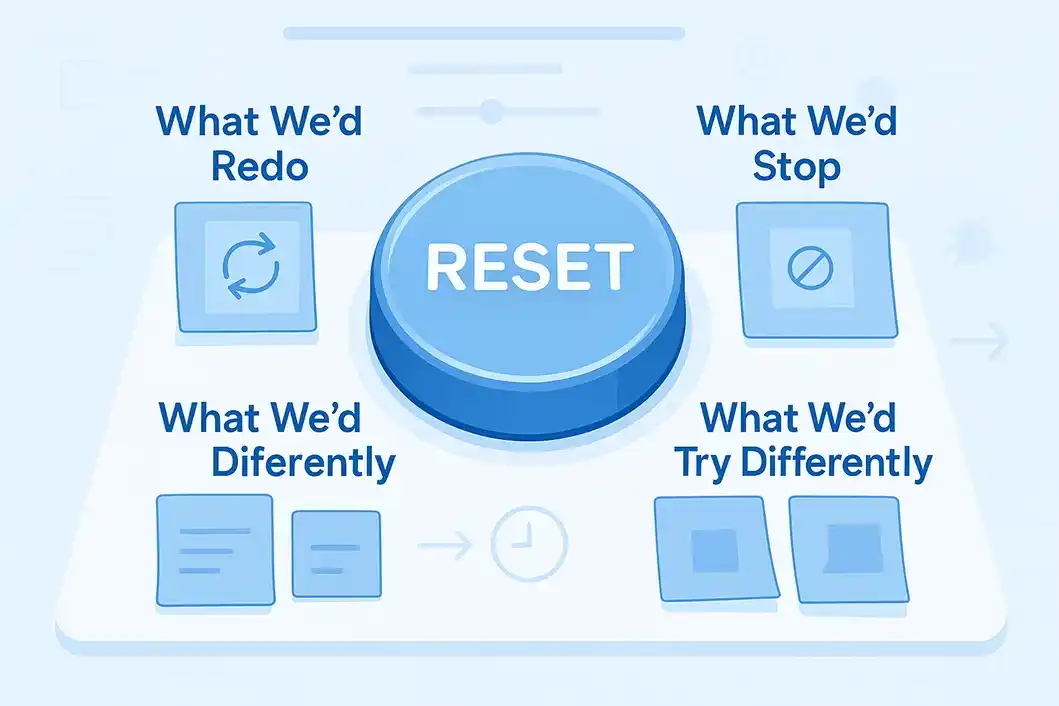
Materials:
How to Play The Reset Button Retrospective?
The Chicken Shoot with Balloons Retrospective is a lively, high-energy retrospective game that brings laughter, movement, and reflection into your sprint review. It’s based on a playful target-shooting concept where balloons represent issues, wins, or ideas, and the “chickens” (team members) aim to pop them by identifying what needs to be addressed.
Goal: To make retrospectives fun, interactive, and effective in surfacing team insights through gamified reflection and action.
Team Size: Ideal for 5–15 participants; adaptable for in-person or remote/hybrid teams with minor tweaks.
Duration: 30–40 minutes.
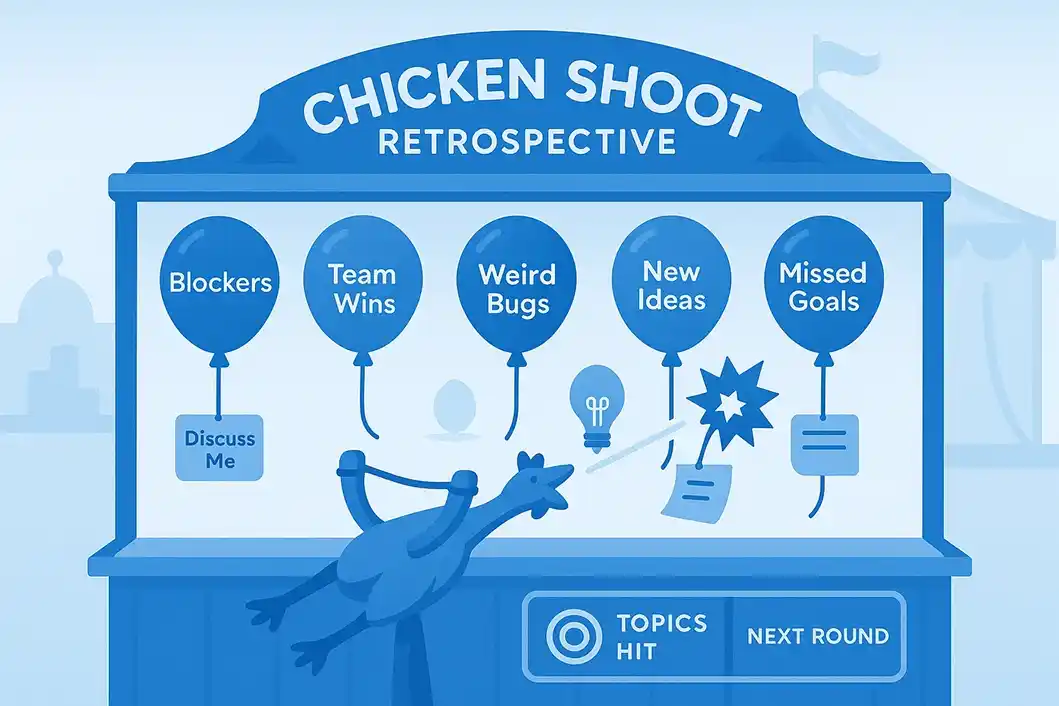
Materials:
How to Play Chicken Shoot with Balloons Retrospective?
Facilitator Tips:
Chicken Shoot with Balloons turns retros into a fun, dynamic experience. This free online retrospective game reduces monotony, boosts engagement, and gets team members excited to participate, while still delivering valuable insights and outcomes.
The Movie Time Retrospective invites your team to view the sprint activities as a film and reflect on it through a cinematic lens. This creative and fun activity encourages storytelling, humor, and metaphor, helping teams analyze events, emotions, and dynamics in a lighthearted but insightful way.
Goal: To reflect on the sprint’s highs, lows, and turning points by framing it as a movie, encouraging storytelling and fresh perspectives.
Team Size: Best for 4–12 participants; works for remote, hybrid, and in-person setups.
Duration: 25–35 minutes.
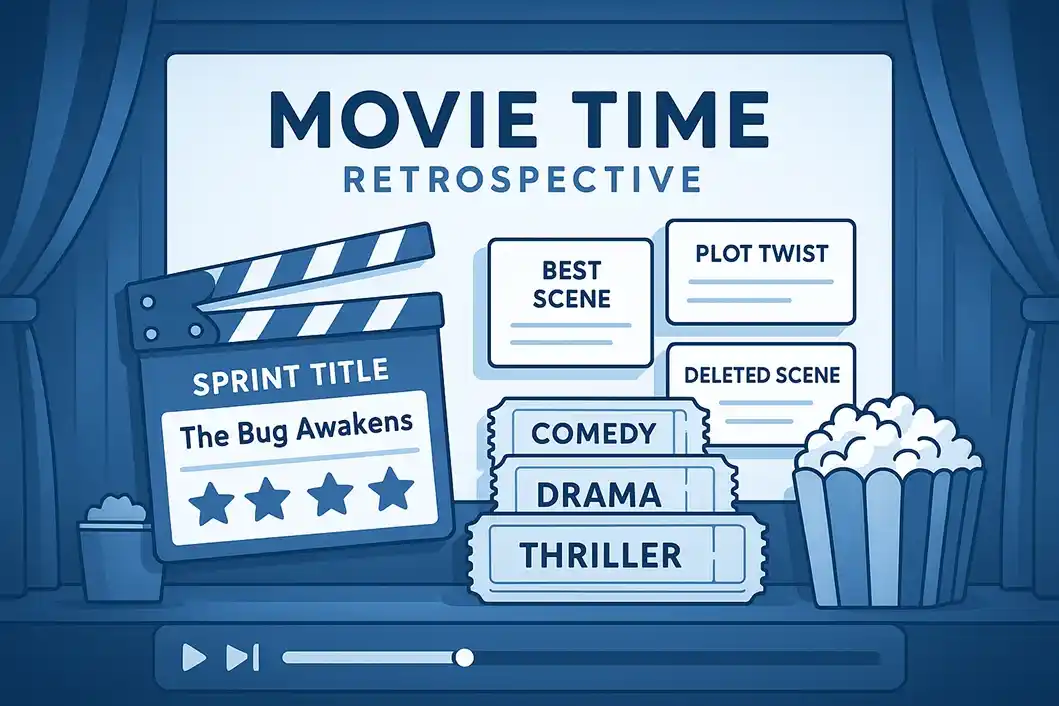
Materials:
How to Play Movie Time Retrospective?
Facilitator Tips
Movie Time turns your retrospective into a storytelling session full of creativity and insight. It lightens the mood, boosts engagement, and helps teams reflect deeply through a fun, metaphorical format, thereby helping build a positive team culture.
The Team Health Check Radar is a data-driven retrospective tool that helps Agile teams assess and visualize their overall health across multiple dimensions—such as communication, collaboration, quality, velocity, and morale. It provides a structured snapshot of where the team stands and highlights areas needing attention or celebration.
Goal: To assess team performance and dynamics holistically, promote self-awareness, and drive continuous improvement through visual feedback.
Team Size: Ideal for 4–15 participants; highly effective for both remote and hybrid teams.
Duration: 30–45 minutes.
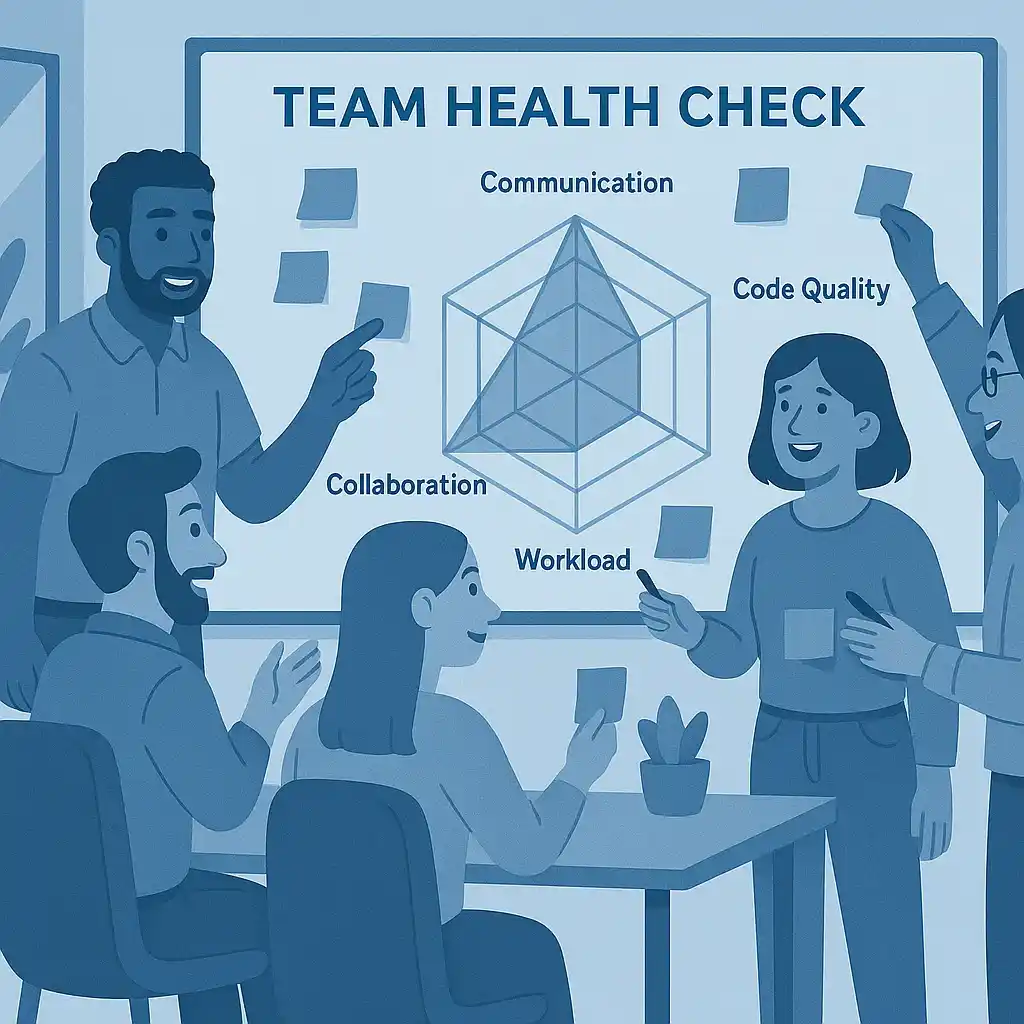
Materials:
How to Play Team Health Check Radar?
Facilitator Tips
The Team Health Check Radar quick fun retrospective game transforms vague feelings into clear, actionable insights. It supports transparency, fosters alignment, and guides focused team growth over time.
Running retrospective games remotely requires more than just moving your in-person format online. It demands intentional design, empathy, the right tools, and a focus on keeping teams engaged across the digital divide.
Here’s how to do it effectively:
Free retrospective games for remote teams can be just as powerful as in-person ones, when facilitated with intention and creativity.
Elevate every retrospective by integrating Clockdiary, a powerful AI-powered time‑tracking and reporting tool that helps teams measure and maximize their return on time spent.
Here’s how its key features support more effective retrospectives:
By leveraging Clockdiary, you can quantify the value of your retrospective games, identify time sinks, and refine format, duration, and facilitation for maximum impact. It’s not only about what discussed today, but how efficiently your team transforms reflection into action tomorrow.
So, what are you waiting for? Make every retrospective truly count with data, clarity, and accountability only with the help of Clockdiary. Get in touch with us to integrate this supremely engineered app into your workflow and see the difference in productivity for yourself.
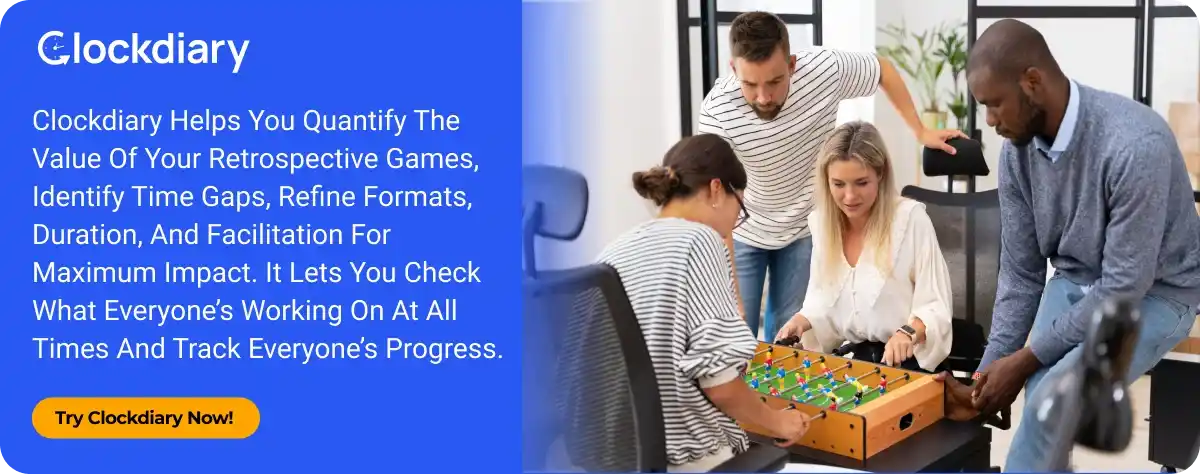
FAQs About Retrospective Games
In Agile methodology, a retrospective is a regular meeting held at the end of each sprint where the team reflects on what went well, what didn’t, and how they can improve moving forward. It’s a core practice for promoting continuous improvement, team alignment, and process optimization.
A retrospective activity is a structured exercise or format used by Agile teams to reflect on their recent work, identify what went well, what didn’t, and how to improve in the next sprint retrospective game. These activities foster open communication, collaboration, and continuous improvement in a safe and engaging way.
The 4Ls of Retrospective stand for Liked, Learned, Lacked, and Longed for—a framework that helps teams reflect on their experiences from multiple perspectives. It encourages balanced feedback by exploring positives, knowledge gained, gaps, and desires for future improvement.
A retrospective meeting should be held at the end of each sprint, typically right after the sprint review and before the next sprint planning session. This timing ensures that the team’s experiences are fresh, allowing for timely reflection and actionable improvements.
A retrospective meeting game is best conducted in a safe, structured, and inclusive environment where every team member feels comfortable sharing honest feedback. Using engaging activities, clear agendas, collaborative tools like Clockdiary, and a skilled facilitator helps keep the discussion focused, productive, and action-oriented.
To make a retrospective more fun, incorporate creative games, visual storytelling, or themed sessions that spark curiosity and break the monotony of traditional formats. Use interactive tools, icebreakers, and light humor to keep energy high while still focusing on meaningful reflection and outcomes.
One of the most fun retrospectives I’ve experienced was the “Movie Time Retrospective,” where team members described the sprint as a film, complete with genre, plot twists, and characters. It sparked laughter, creativity, and deep insights, making the session both memorable and meaningful.